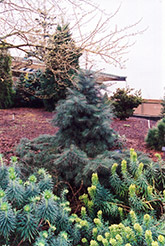Weeping White Fir
Abies concolor 'Pendula'
Height: 10 feet
Spread: 8 feet
Sunlight:
![]()
![]()
Hardiness Zone: 4
Other Names: Silver Fir, Concolor Fir, Colorado Fir
Description:
An unusual small accent shrub for the garden noted for its pendulous, trailing habit and good bluish-white foliage color, use to draw attention to a part of the home garden; avoid hot or dry, windy sites
Ornamental Features
The Weeping White Fir is a dwarf conifer which is primarily valued in the landscape or garden for its highly ornamental weeping form. It has attractive silvery blue evergreen foliage. The needles are highly ornamental and remain silvery blue throughout the winter.
Landscape Attributes
The Weeping White Fir is a multi-stemmed evergreen shrub with a rounded form and gracefully weeping branches. Its average texture blends into the landscape, but can be balanced by one or two finer or coarser trees or shrubs for an effective composition.
This is a relatively low maintenance shrub, and usually looks its best without pruning, although it will tolerate pruning. It has no significant negative characteristics.
The Weeping White Fir is recommended for the following landscape applications;
- Accent
- General Garden Use
Planting & Growing
The Weeping White Fir will grow to be about 10 feet tall at maturity, with a spread of 8 feet. It tends to fill out right to the ground and therefore doesn't necessarily require facer plants in front, and is suitable for planting under power lines. It grows at a slow rate, and under ideal conditions can be expected to live for 80 years or more.
This shrub does best in full sun to partial shade. It prefers to grow in average to moist conditions, and shouldn't be allowed to dry out. It is not particular as to soil type or pH. It is somewhat tolerant of urban pollution, and will benefit from being planted in a relatively sheltered location. Consider applying a thick mulch around the root zone in winter to protect it in exposed locations or colder microclimates. This is a selection of a native North American species.
